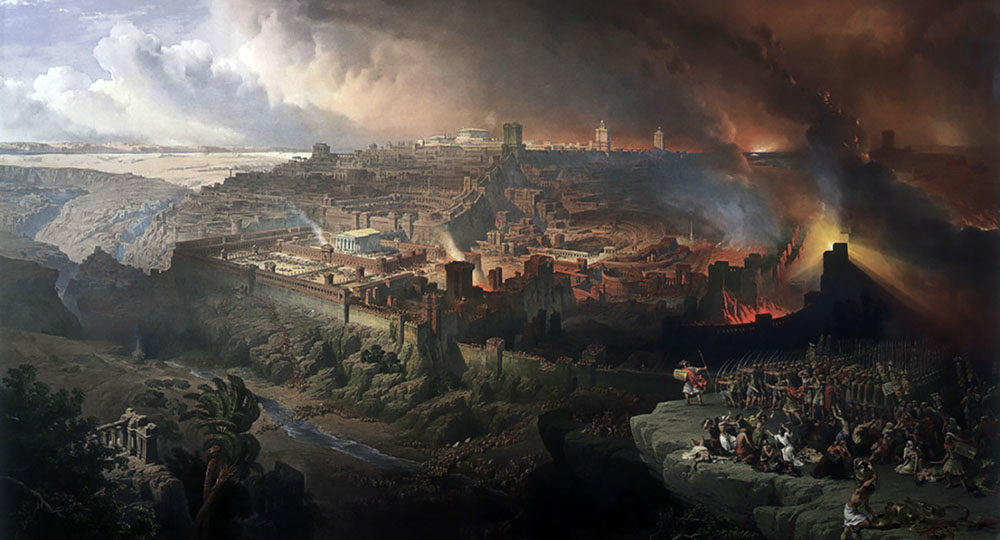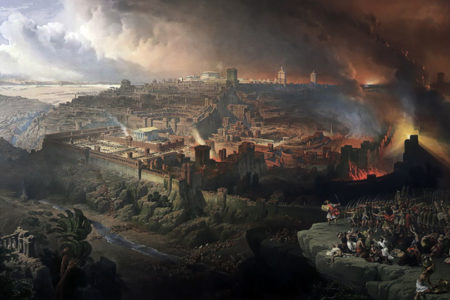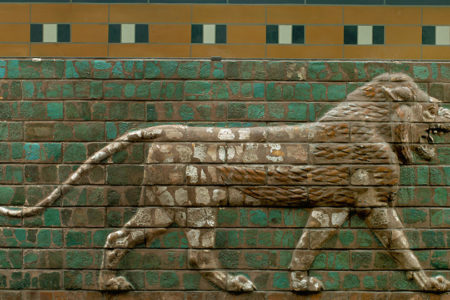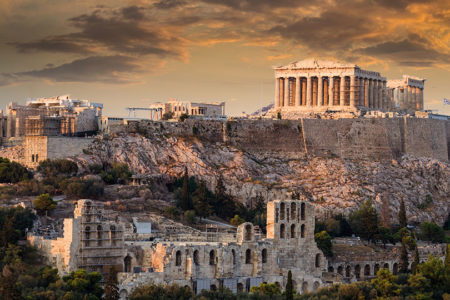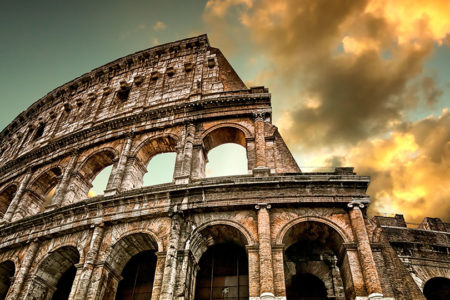From Babylon To Bethlehem
And there lay the rider distorted and pale,
With the dew on his brow, and the rust on his mail:
And the tents were all silent, the banners alone,
The lances uplifted, the trumpet unblown.
And the widows of Ashur are loud in their wail,
And the idols are broke in the temple of Baal;
And the might of the Gentile, unsmote by the sword,
Hath melted like snow in the glance of the Lord!
Lord Byron, in “The Destruction of Sennacherib,” caught in vivid poetic form not only the essence of a battle long gone, but the final convulsions of the “times of the Gentiles.” Thus, human observation confirms the prophetic declaration of a period of Gentile domination until, in the words of Jesus, “the times of the Gentiles be fulfilled” (Lk. 21:24). That the conclusion of the era of the Gentiles is related to “Jerusalem [being] trodden down by the Gentiles” at once clarifies the importance of events taking place in the Middle East and shapes the entire prophetic program set forth in the Scriptures.
As you will observe in the articles to follow, God has provided precise information of the course and destiny of Gentile empires that followed Nebuchadnezzar and the first kingdom, Babylon. Few areas of human history are more intriguing than the development and demise of successive empires that have conspired to dominate the world and capture its most prized possessions, Israel and Jerusalem. I say without hesitation that Israel and Jerusalem are most prized by the Gentiles because, in the final analysis, all significant empires have aspired to possess the land and the Holy City. Herein lies the surpassing story of supreme human aspirations and the divine dedication of Jehovah to the land, its people, and the City of Peace, Jerusalem. At one and the same time it identifies the battle lines drawn between Satan and God, light and darkness, peace and chaos.
Parade of the Nations
In their turn, they have all come to the land of the Jews. The four great empires—Babylon, Medo-Persia, Greece, and Rome—have been there and are gone. A reconstituted form of Rome will make a return trip in the days ahead.
Before them, the likes of Egypt and Assyria planted banners and left monuments to the gods they believed crafted their triumphs. When Rome crumbled as a viable force in the ancient world, lesser invaders—Byzantines, Arabs, Seljuks, Crusaders, Mamluks, Ottoman Turks, French, and others—vied for supremacy in Eretz Israel. Names like Napoleon and Britain’s Allen by turn up in the latter stages of the countdown for the return of the Jews in our time. The point is that over the centuries little Israel and her capital city of Jerusalem have been at the center of the great international tug-of-war that will consummate where so many in ancient and more recent times have struggled—near the hill Megiddo in the Jezreel Valley, Armageddon. At the moment we seem to be in the warm-up for the political and military convulsions that will dwarf all that has gone before. This time around there will be no limited engagements; the conflict will be a winner-take-all contest of global proportions.
The return of the Jews and the rebirth of Israel sent a wake-up call to the nations of the Middle East, and the area that had been viewed as a rather slow-paced region of the world began to stir perceptibly. Arab Muslim neighbors began their frenzied military attempts to rewrite the map and, for that matter, the history of the land. Indeed, big things began to develop on the world stage in proximity to the new national reality in the Middle East. One might safely say that when the Lord began to stir the heart of Jewry for her land, Satan sent a wake-up call to his troops and launched the great counter strategy that is unfolding at an ever-increasing pace.
Europe, fragmented for centuries, began what many prophetic scholars believe to be the move toward reconstituting the Roman Empire. Echoes can be heard of Daniel’s prophecy of an end-time entity in Europe that will produce the world’s most colossal dictator. In the present international mix, the United States, Russia, and successive legions of great and lesser nations in the United Nations wrangle and vote over issues related to Israel with a heat of passion seemingly reserved for it alone. It is fascinating to observe that, as the world makes obvious moves toward a one-world system, the United Nations these days seems to be preoccupied with minding the business of everyone else on the planet. With UN Secretary-General Boutros Ghali’s posturing as the world’s military leader and the United States’ off-again on-again threats to sanction, bomb, or send troops into places fingered by the world body as trouble spots, few can doubt that, from the prophetic point of view, things are heating up.
Jerusalem: A Thermometer for the End Times
When talk first began about peace between Israel and her antagonists in the Middle East, Jerusalem was a subject place, to say the least, on the back burner. So volatile was the issue of Jerusalem that, not only did no one want to open the Pandora’s box of problems related to settlement, but some rather bizarre decisions were made in an attempt to avoid trouble. In 1947 the United Nations, as part of its resolution plan for Palestine, proposed that “the City of Jerusalem shall be established as a corpus separatum under a special international regime and shall be administered by the United Nations.” The rationale for internationalizing Jerusalem was not applied to any other city in the nations created out of the Mandatory period. Bottom line—Gentiles would rule the place God had long since designated as the undisputed capital city of the Jewish nation.
Arab Muslims rejected the entire partition plan, moved to eliminate the state, seized Jerusalem (in open defiance of the United Nations), and promptly closed the city to Jews. For 19 years Jerusalem endured a squalid situation, and no one in the United Nations seemed to notice.
That all changed, of course, during the Six–Day War. As Jerusalem was united, the barriers were taken down, shrines of all faiths were opened for free access, and all residents—Jews, Arabs, Christians—were allowed to pursue their lives in relative security. The United Nations did notice this time, however, and catcall sanctions against the “occupation” were raised from time to time.
For Israel’s part, the city was at last united and declared the undivided capital of the Jewish state. Randolph Churchill and Winston Churchill (son and grandson of the former British Prime Minister), in The Six–Day War, commented on the reunification: “Three laws were passed through the Knesset on June 27 annexing the Old City of Jerusalem and reuniting it with the New on the next day. Whatever else Israel may be prepared to negotiate we may be sure Jerusalem is not included.”
In another rather strange twist of international thinking, only two nations, Costa Rica and El Salvador, recognized Jerusalem as the capital city of Israel. One wonders when any sovereign state was refused “permission” from the United Nations to choose and designate its own capital city.
But under firm and fair Israeli control, Jerusalem flourished and, from all appearances, was indeed the nonnegotiable center of the Jewish world. Until, that is, a man in a kaffiyeh and another with an automatic rifle came to the stage. Yasser Arafat settled for limited autonomy—temporarily. He has made no secret of the fact that the peace process is only the “first step” on the road to Palestinian statehood. The capital city of that state is to be Jerusalem. That is his settled agenda, and the world seems to assume this will ultimately be the case.
Dr. Baruch Goldstein brought the issue of Jerusalem to the front burner when he shot nearly 30 worshipers in Hebron. In the wave of emotional hysteria that followed, the United Nations sought out a nation to blame for the misdeeds of one deranged man. Predictably, Israel was the culprit. To assuage Muslim rage and, in the process, throw another concession their way, the world body voted Jerusalem “occupied territory.” For the first time in the history of the modern State of Israel, the United States forfeited its moral obligation to veto such rancorous nonsense and, in the process, contributed significantly to more trouble for Israel and, for that matter, the peace process. In short, one may say that the Gentile nations are once again exercising their intention to place a firm foot on Jerusalem.
The Vatican stated as much with the decision to establish diplomatic relations with Israel. The primary objective of the Vatican is to be positioned to exercise authority in the international body that will begin to negotiate the “final status” of Jerusalem in 1998. You can be sure that the “final status” settlement will not designate Jerusalem as the united capital city of Israel but, rather, as an internationally controlled hodgepodge that will satisfy no one. We can, however, learn one great thing from all of this: The nations are on the move, and they are moving toward the eventual showdown in the Middle East.
Bethlehem’s Answer to Babylon’s Dream
The very good news for all of us is that God has anticipated the Gentile obsession to dominate and then subjugate His creatures and creation. Consequently, His response has been determined and is in motion.
It became physically visible to humans at Bethlehem when, by way of a virgin womb, deity took on humanity. His birth was the living embodiment of all that the prophets had promised the Messiah would be.
Oddly enough, nearing the completion of His redemptive cross work, He revealed the full scope of His earthly mission. I say “oddly enough” because Jesus’ grand revelation of a future reality was made to Pilate, emissary of imperial Rome, in Jerusalem nearly 2,000 years ago.
“Pilate, therefore, said unto him, Art thou a king, then? Jesus answered, Thou sayest that I am a king. To this end was I born, and for this cause came I into the world” (Jn. 18:37).
At the hour of His greatest humility, He exposed His coming majesty.
Appropriately, Jesus mapped the future course laid down by the Prophet Daniel. When speaking of the phases of the Messiah’s ministry, he wrote: “And after threescore and two weeks shall Messiah be cut off [crucified], but not for himself” (Dan. 9:26)—in other words, having not received His kingdom. This cutting off, according to Daniel’s prophecy, would occur before the city was destroyed in AD 70.
Thus, what the Messiah was saying to Pilate was, “Yes, I am a King, but a King for another time, if not another place.” I suppose one can look at it this way: Jesus was telling Rome’s man in Jerusalem that they would meet again one distant day, but under far different circumstances. Oh, Pilate will not be there, of course, but a far more crude and wily character than he ever was will face the Christ—we call him the Antichrist. So, while we scan events touching developments of the Gentile plan to sweep the planet with its marauding hordes, seize Israel, and triumph over Jerusalem, we confidently look for that promised fifth kingdom and pray for its coming.
I saw in the night visions, and, behold, one like the Son of man came with the clouds of heaven, and came to the Ancient of days, and they brought him near before him. And there was given him dominion, and glory, and a kingdom, that all people, nations, and languages should serve him; his dominion is an everlasting dominion, which shall not pass away, and his kingdom that which shall not be destroyed (Dan. 7:13–14).
All believers who long for true peace can confidently look forward to the day when they will walk in white on the streets of a Jerusalem fit for the King.
